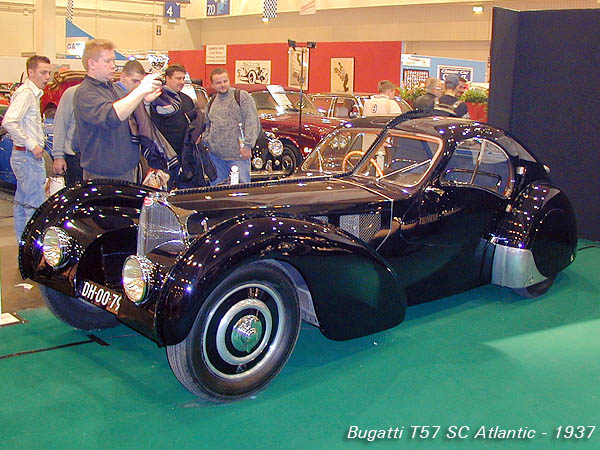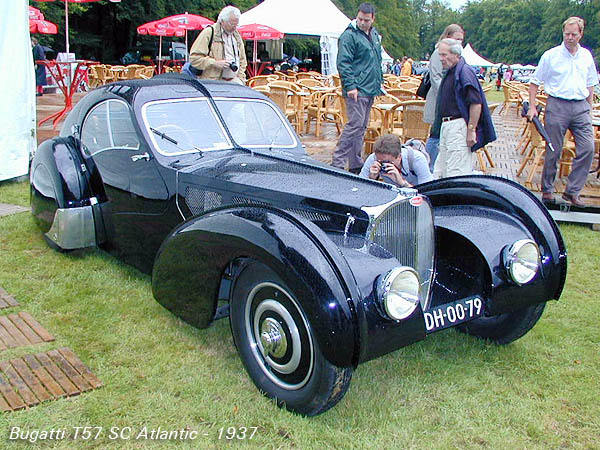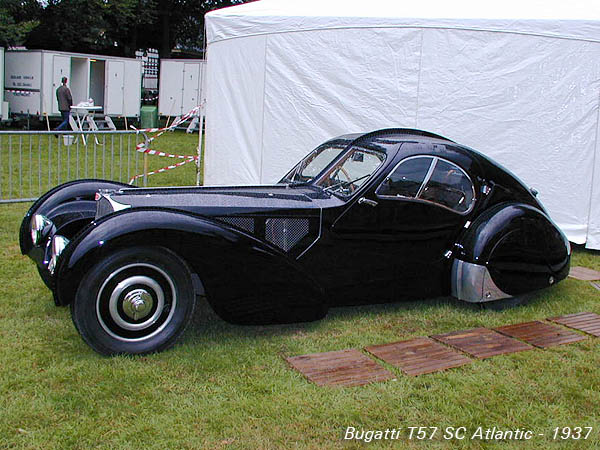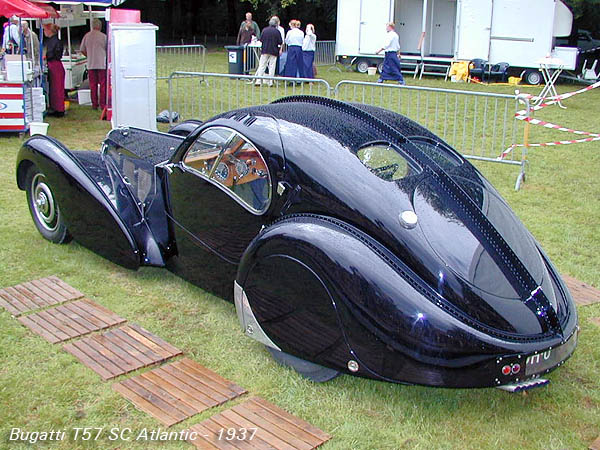Next to the introduction of the Atalante model in 1935 an experimental model on the standard Type 57 chassis appeared: the Aérolithe. This car created quite a stir with its unusual, almost hunched body style and its ability to reach a maximum speed of 200 kph. It attracted enough interest to consider taking it into production, and so the Atlantic was presented in 1936 as the production version of the Aérolithe.
 It was to become the rarest and most exotic of all Type 57 Bugattis. The Atlantic can be regarded as the sportscar version of the Atalante, with innovative streamlined 2-seater fastback coupe bodywork on the low and short S chassis and with the tuned 8-cylinder 3257 cc engine, fitted with the compressor option. It was to become the rarest and most exotic of all Type 57 Bugattis. The Atlantic can be regarded as the sportscar version of the Atalante, with innovative streamlined 2-seater fastback coupe bodywork on the low and short S chassis and with the tuned 8-cylinder 3257 cc engine, fitted with the compressor option.
The Atlantic followed the essence of the Aérolithe, as the name indicates an aerodynamic lightweight car, but without the unaffordable magnesium alloy ("Electron") body construction, though at least one Atlantic had an aluminum alloy body. By fitting the Atlantic body shell on the S chassis instead of the standard chassis it became even more dynamic than the Aérolithe.
 The design of the Atlantic, again the work of an inspired Jean Bugatti, showed a resemblance with another contemporary French styling icon: the Talbot-Lago T150 SS "Goutte d'Eau" (teardrop) coupe by Figoni and Falaschi, but was in an unique way ahead of its time. There were similarities with aircraft construction, like its most distinctive feature: the ridge running from front to back over the middle of the car which was formed by the flanges with which the 2 halves of the body shell were riveted together. This feature was carried over from the Aérolithe prototype, that had a magnesium alloy body which could not be welded. On the Atlantic it was more of a decorative addition, though some say it added to the rigidity of the construction and stabilized the car at high speeds. This feature was also repeated on the front fenders of the car. The design of the Atlantic, again the work of an inspired Jean Bugatti, showed a resemblance with another contemporary French styling icon: the Talbot-Lago T150 SS "Goutte d'Eau" (teardrop) coupe by Figoni and Falaschi, but was in an unique way ahead of its time. There were similarities with aircraft construction, like its most distinctive feature: the ridge running from front to back over the middle of the car which was formed by the flanges with which the 2 halves of the body shell were riveted together. This feature was carried over from the Aérolithe prototype, that had a magnesium alloy body which could not be welded. On the Atlantic it was more of a decorative addition, though some say it added to the rigidity of the construction and stabilized the car at high speeds. This feature was also repeated on the front fenders of the car.
 Other distinctive styling features of the Atlantic were the high sills (due to incorporating the chassis members within the body construction to reduce the height of the body) which made it necessary to cut out the doors high on the sides and partly into the roof to allow for easy entering and exiting the car; the side windows which followed the roof line; the typical V-ed radiator shell of the S chassis which was placed low between the front fenders, and the turtle-like rear deck. Altogether it formed a slightly bizarre but very impressive and appealing statement which inspired designers and cars for decades to come. It certainly wasn't like anything on the road in the 1930s and for the people at the time it might just as well have come from outer space. Other distinctive styling features of the Atlantic were the high sills (due to incorporating the chassis members within the body construction to reduce the height of the body) which made it necessary to cut out the doors high on the sides and partly into the roof to allow for easy entering and exiting the car; the side windows which followed the roof line; the typical V-ed radiator shell of the S chassis which was placed low between the front fenders, and the turtle-like rear deck. Altogether it formed a slightly bizarre but very impressive and appealing statement which inspired designers and cars for decades to come. It certainly wasn't like anything on the road in the 1930s and for the people at the time it might just as well have come from outer space.
 This, and its exorbitant price, made the Atlantic hard to sell. Though its agility was undoubted, its pedigree revered and its design much acclaimed, only a few left the factory between 1936-1938. Apparently parts were made for 6 Atlantics but only 3 were sold, all fitted with compressor. Two of these have survived to this day and one was (re)assembled from remaining parts, so now 3 original Atlantics are extant. This, and its exorbitant price, made the Atlantic hard to sell. Though its agility was undoubted, its pedigree revered and its design much acclaimed, only a few left the factory between 1936-1938. Apparently parts were made for 6 Atlantics but only 3 were sold, all fitted with compressor. Two of these have survived to this day and one was (re)assembled from remaining parts, so now 3 original Atlantics are extant.
After WW2 when streamlined design became rapidly accepted, the Atlantic soon was seen as a lighting example and a work of art. The value of the few cars left went sky high and now it's one of the most expensive classics in the world. And one of the most beautiful in my opinion.
To be honest: the Atlantic shown here is an exact replica made by Erik Koux from Denmark, based on original Bugatti parts but with new, exactly recreated, chassis and body. Of the 3 remaining Atlantics 2 reside in the US and 1 in France, so this fine replica will have to do for now...
|
